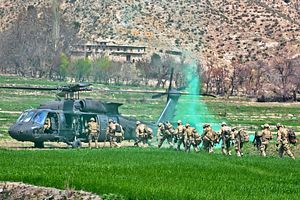Jani Khel district in eastern Afghanistan fell to the Taliban Friday night, with high casualties inflicted on Afghan security forces. After several days of siege by Taliban forces and no resupply to besieged Afghan troops, the strategic district located in Paktia province collapsed.
“We were 90 people, and we had to fight against 1,200 Taliban,” Jani Khel’s district governor told The New York Times. “Twenty-seven of my men have been killed. At first, some of them were wounded and we brought them to the main road, but then a land mine exploded and they were killed. We killed 130 of the enemy.”
Governor Abdul Rahman Solamal told Tolo News in a separate interview that 30 security forces were killed in the attack, and about 1,200 Taliban forces were involved in the operation.
Furthermore, provincial authorities believe the Taliban, specifically the Haqqani Network, were assisted by Pakistan’s Inter-Services Intelligence (ISI), the formidable spy network that many believe is responsible for Pakistan’s defense policy of strategic-depth — the idea of destabilizing Afghanistan as a backdrop to an invasion by India.
The Haqqani Network, led by Sirajuddin Haqqani, is one of the most brutal networks in Afghanistan, associated with many high profile attacks in Afghanistan and Kabul. The group is listed as a terrorist organization by the U.S. State Department, and so are three of its leaders. Its leader, Sirajuddin Haqqani, was made the deputy leader of the Taliban by Haibatullah Akhundzada, the group’s current supreme leader after a U.S. airstrike killed Mullah Mansour late this Spring.
The collapse of Jani Khel district has stoked fears that the Haqqani Network may utilize the region as a springboard for attacks in Kabul; moreover, the district’s geographic location offers strategic and tactical value to any force that controls it.
Located in eastern Afghanistan Paktia province, the district borders Khost province. Linking the two provinces is a key highway that leads from Khost to the provincial capital of Gardez in Paktia. The fall of Jani Khel threatens to destabilize neighboring districts such as Jadran, Shwack, and Gardez, the collapse of which would provide the Haqqani Network access to move guns, money, supplies, and forces from tribal areas in Pakistan through the Khost-Gardez highway.
The region also has historical significance, especially to the Haqqani, as it served as the site of one of the largest defeats for the Haqqani Network under Jalaluddin Haqqani to the Soviets during the battle of Hill 3234. In an effort to maintain control over the Khost-Gardez highway, a main resupply point, Soviet forces defended the hill with only 39 men against several hundred of Jalaluddin’s fighters.
The destabilization and fall of Jani Khel is the first possible stage in Haqqani establishing a secure foothold in eastern Afghanistan — the prospect of which could make Kabul a far bloodier scene.
According to Tolo News, Coalition aircraft have launched airstrikes in Jani Khel district to assist Afghan operations to retake the fallen district. The airstrikes have reportedly killed 130 Taliban forces, including the Taliban designated district chief.

































